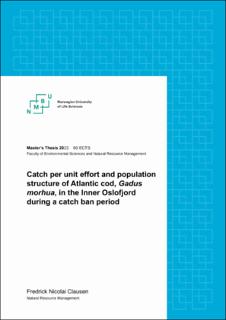| dc.description.abstract | Atlantic cod populations in the inner Oslofjord have faced a serious decline due to overharvesting. Since 2019, a cod catch ban has been in effect, rendering all harvesting of the species in the Oslofjord illegal. This study aims to assess catch per unit effort, condition, and age distribution of cod in two areas in the fjord. One area is in the inner Oslofjord and have been sampled 1-3 times per year in 2019-2022. The other area is just north of the Drøbak sound and has seen sampled once per year in 2021-2022. In each zone, 20 fyke nets were placed randomly and stratified and checked every second day for a week. Tissue samples, scale samples, weight and length were taken for caught cod. Catch data was used to calculate catch per unit effort (CPUE) and was compared to studies published in both 2021 and 2013. Condition factor was calculated using weight and length measurements and scales were used to estimate age and back-calculate length-at-age.
CPUE in the inner fjord zones was around 0,2 cod per trap per day, with very little change over the years. CPUE in the Drøbak area in 2021 was extremely high (0,520,58) which was more than double the value form the inner fjord zones in 2012 (0,310,23). Condition factor in Drøbak averaged around 0,95, while in the inner zones it had dropped from around 0,9 in 2019 to around 0,7 in 2022, which is very poor. Age structure for inner fjord cod changed and included higher percentages of individuals 5-8 years old (32 %) in 2022 than before. No cod older than five years were caught in Drøbak, indicating this as the maximum age in that area. Back-calculated length for Drøbak cod was 2-5 cm shorter than individuals of the same age from the inner fjord zones. Instantaneous mortality dropped from Z=0,614 before the catch ban to Z=0,596 after the catch ban in the inner fjord zones. In Drøbak it was at Z=0,576.
The results do not indicate recovery of the cod population in the inner Oslofjord after the catch ban but showed higher CPUE levels in Drøbak. Drøbak cod also had higher condition factor, but were shorter and died earlier, perhaps because of fishing. Poor condition factor may have reduced recruitment in the inner fjord cod, but the catch ban is helping as we see an increased abundance of older than 5-year-old cod, as should be expected in a population not subjected to harvest. | |
